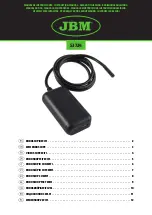
BAM 1020-9800 Manual Rev W.docx
Page 55
7.2 BAM 1020 Error and Alarm Descriptions
The following table describes the BAM 1020 error and alarm codes. Errors are grouped into
twelve categories. If an error or alarm occurs, it will appear at the end of the hourly digital
data array as a simple
“1” bit in one of the twelve error bit positions. This allows data
collection systems to easily identify errors. See Section 9 for data examples. Errors and
alarms are also stored in the separate BAM digital error log file, which contains more detail
about the specific sub-category cause of the alarm.
Note: In general, any error which prevents the BAM 1020 from making a valid, hourly
concentration measurement will also cause the digital concentration value to be stored as a
full-scale value (usually 0.985 mg) in order to indicate invalid data. In most cases, critical
errors will also force the analog output to full-scale (1.00V). The rules for which errors cause
invalid data and full-scale values have varied slightly with past revisions of firmware. The
following descriptions explain these conditions in as much detail as possible. If an error
occurs in your unit which does not seem to agree with this description, please note your
firmware revision and contact Technical Service.
Code
Error/Alarm Type
Error/Alarm Description
E
External Reset
or
Interface Reset
This alarm indicates that an external data logger sent a clock synchronization signal
to the BAM on the EXT RESET input, but the BAM was unable to reset its clock,
because it occurred outside of the allowable time window. Hourly clock reset signals
will be ignored by the BAM from minutes 5-54 (standard cycle) or minutes 0-49 (early
mode). See Section8.2.The alarm will also be generated if the synch signal occurs
within the acceptable window near the end of the hour, but before the BAM has
finished the previous concentration calculation. The digital error log will indicate
which of these two has conditions occurred. If an external clock reset event is
successful, then no alarm is logged. These alarms do not prevent the BAM from
storing a valid data record for the sample hour.
Manually set the BAM 1020 clock to match the data logger clock initially. This should
cause subsequent clock synch events to succeed. Make sure the BAM lithium
battery is functional.
U
Telemetry Fault
or
Interface Fault
This alarm indicates that an external data logger has sent an error signal to the BAM
1020 on the TELEM FAULT input, indicating that the logger unit has encountered a
problem. This feature is almost never used. These alarms do not prevent the BAM
from storing a valid data record for the sample hour.
M
Maintenance Alarm
This alarm almost always indicates that the sample cycle was stopped because
someone entered a SETUP or TEST menu for calibration or testing purposes.
Maintenance flags always cause the digital concentration value to go full-scale for
that hour, because the sample cycle was not finished.
I
Internal Error
or
Coarse Link Down
The “I” error is rare, and indicates that an error occurred in the BAM concentration,
mass, span, or stability calculation which prevented the generation of a valid
concentration value. The digital error log will indicate which of these calculations has
failed. The concentration value is set to full-scale due to invalid data. This may
indicate a problem in the digital circuitry.
In BAM 1020 units configured as the PM
10
master unit in a PM-
coarse pair, the “I”
alarm indicates that the digital link between the two units is down, and the master
unit could not obtain the PM
2.5
value from the slave unit and thus could not calculate
a coarse value. The coarse and PM
2.5
values will be full-scale.
















































